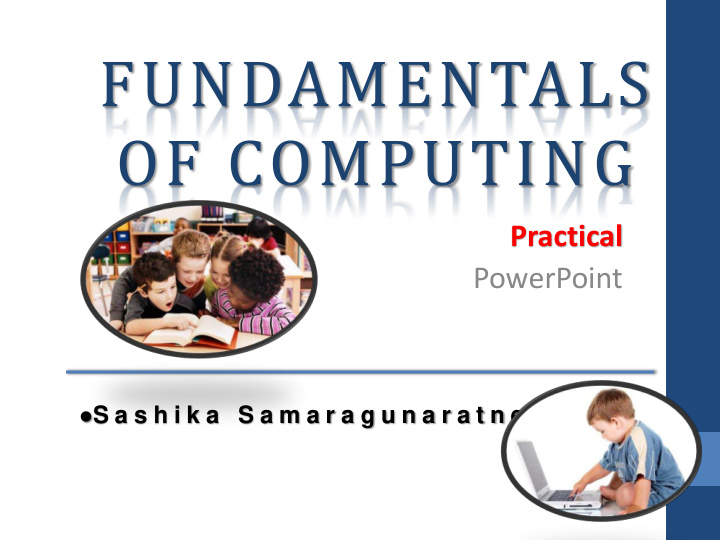



FUNDAMENTALS OF COMPUTING Practical PowerPoint ⚫ S a s h i k a S a m a r a g u n a r a t n e
Contents • Microsoft PowerPoint • Contents • Layout • Slide Master • Themes • Slide Structure • Fonts • Colour • Background • Graphs • Spelling and Grammar • Conclusions 2 • Questions
Contents (cont’d) • Microsoft Word • Lists • Numbering • Headings • Page numbers • Figures / Tables /Charts / Equations • Table of contents • Table of figures /tables / equations 3
11/8/2019 MICROSOFT POWERPOINT 4
Contents • Make your 2 nd slide an outline of your presentation • Ex: previous slide • Follow the order of your outline for the rest of the presentation • Only place main points on the outline slide • Ex: Use the titles of each slide as main points 5
Slide Layout • Slide layouts contain formatting, positioning, and placeholders for all of the content that appears on a slide. • Placeholders are the containers in layouts that hold such content as text (including body text, bulleted lists, and titles), tables, charts, SmartArt graphics, movies, sounds, pictures, and clip art. • Slide layouts also contain the theme (colors, fonts, effects, and the background) of a slide. 6
Slide Layout 7
Slide Master • When you want all your slides to contain the same fonts and images (such as logos), you can make those changes in one place — the Slide Master, and they'll be applied to all your slides. 8
Themes • A theme is a palette of colors, fonts, and special effects (like shadows, reflections, 3D effects, and more) that complement one another. 9
Slide Structure – Good • Use 1-2 slides per minute of your presentation • Write in point form, not complete sentences • Include 4-5 points per slide • Avoid wordiness: use key words and phrases only 10
Slide Structure - Bad • This page contains too many words for a presentation slide. It is not written in point form, making it difficult both for your audience to read and for you to present each point. Although there are exactly the same number of points on this slide as the previous slide, it looks much more complicated. In short, your audience will spend too much time trying to read this paragraph instead of 11 listening to you.
Slide Structure – Good • Show one point at a time: • Will help audience concentrate on what you are saying • Will prevent audience from reading ahead • Will help you keep your presentation focused 12
Slide Structure - Bad • Do not use distracting animation • Do not go overboard with the animation • Be consistent with the animation that you use 13
Fonts - Good • Use at least an 18-point font • Use different size fonts for main points and secondary points • this font is 24-point, the main point font is 28- point, and the title font is 36-point • Use a standard font like Times New Roman 14 or Arial
Fonts - Bad • If you use a small font, your audience won’t be able to read what you have written • CAPITALIZE ONLY WHEN NECESSARY. IT IS DIFFICULT TO READ • Don’t use a complicated font 15
Colour - Good • Use a colour of font that contrasts sharply with the background • Ex: blue font on white background • Use colour to reinforce the logic of your structure • Ex: light blue title and dark blue text • Use colour to emphasize a point • But only use this occasionally 16
Colour - Bad • Using a font colour that does not contrast with the background colour is hard to read • Using colour for decoration is distracting and annoying. • Using a different colour for each point is unnecessary • Using a different colour for secondary points is also unnecessary • Trying to be creative can also be bad 17
Background - Good • Use backgrounds such as this one that are attractive but simple • Use backgrounds which are light • Use the same background consistently throughout your presentation 18
Background – Bad • Avoid backgrounds that are distracting or difficult to read from • Always be consistent with the background that you use 19
Graphs - Good • Use graphs rather than just charts and words • Data in graphs is easier to comprehend & retain than is raw data • Trends are easier to visualize in graph form • Always title your graphs 20
Graphs - Good 21
Graphs - Bad 22
Graphs - Bad 23
Graphs - Bad • Minor gridlines are unnecessary • Font is too small • Colours are illogical • Title is missing • Shading is distracting 24
Spelling and Grammar • Proof your slides for: • speling mistakes • the use of of repeated words • grammatical errors you might have make • If English is not your first language, please have someone else check your presentation! 25
Conclusion • Use an effective and strong closing • Your audience is likely to remember your last words • Use a conclusion slide to: • Summarize the main points of your presentation • Suggest future avenues of research 26
Questions?? • End your presentation with a simple question slide to: • Invite your audience to ask questions • Provide a visual aid during question period • Avoid ending a presentation abruptly 27
THANK YOU 28
Recommend
More recommend